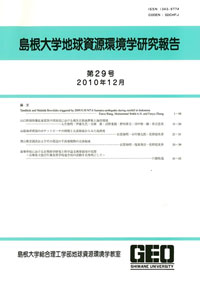島根大学総合理工学部地球資源環境学教室
ISSN:1343-9774

number of downloads : ?
Use this link to cite this item : https://ir.lib.shimane-u.ac.jp/7327
Geoscience reports of Shimane University 28
2009-12-25 発行
島根県中部,馬路高山-矢滝城山地域における大江高山火山噴出物の岩相分布とそれに関連した斜面運動
Lithofacies distribution of the Quaternary Oe-takayama Volcanic Products and related slope movements in the Maji-takayama to Yataki-shiroyama areas, Central Shimane, Japan
Kimura, Takeshi
Tamura, Yukio
Yokota, Shuichiro
File
Description
Field mapping of lithofacies distribution has been made to establish the volcanic stratigraphy of the Quaternary Oetakayama Volcanic Products in the Maji-takayama to Yataki-shiroyama areas, Central Shimane, Japan. The presence of at least three lava flow layers and three pyroclastic flow deposits were confirmed in the areas. With the exception of the lowest unit, the lavas and flow deposits are not continuous, and lateral change of lithofacies is remarkable. Fluvial gravels with thin tuffaceous silt layers also frequently occur, in addition to tuff breccias. Considering that the gravels are characterized by abundant dacite fragments, these may be correlative with the Shimano-hoshi Formation in the Gotsu area.
The area is characterized by various slope movements including toppling, translational sliding, and debris avalanches. These movements occur not only on steep slopes on dacite, but also on varying slopes in other lithofacies. Especially, thin silt layers interbedded with tuff breccias sometimes cause local landslides because they are kinetically weak layers with impermeable properties. Consequently, the types of slope movements strongly depend on the lithofacies and slope structures in the areas.
The area is characterized by various slope movements including toppling, translational sliding, and debris avalanches. These movements occur not only on steep slopes on dacite, but also on varying slopes in other lithofacies. Especially, thin silt layers interbedded with tuff breccias sometimes cause local landslides because they are kinetically weak layers with impermeable properties. Consequently, the types of slope movements strongly depend on the lithofacies and slope structures in the areas.
Other Article
PP. 51 - 63
